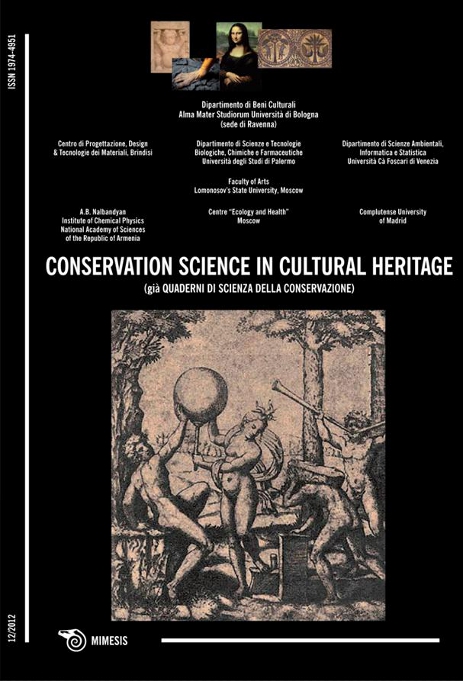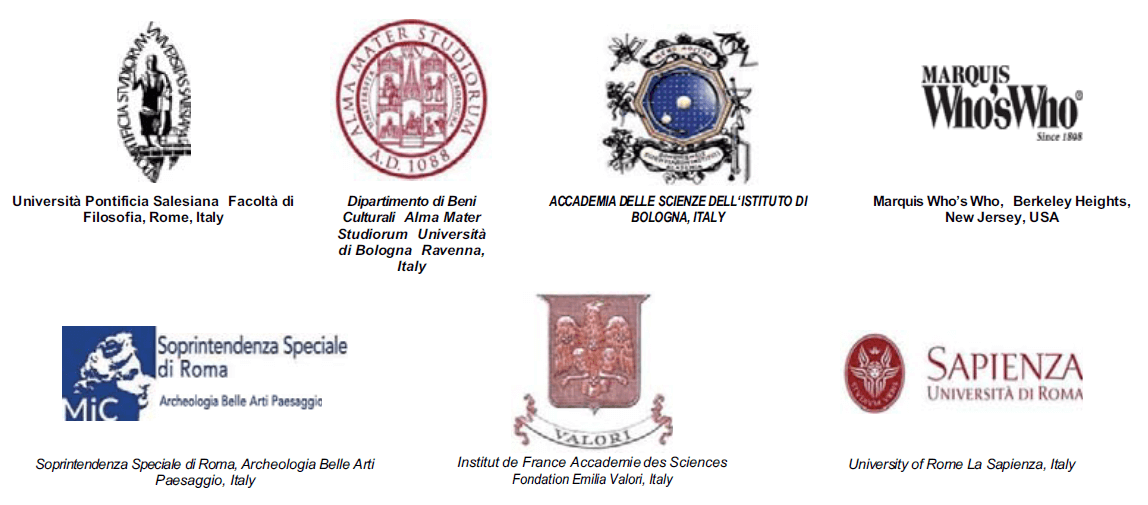Preventive conservation strategies for wax bodies in scientific university collections
DOI:
https://doi.org/10.6092/issn.1973-9494/3400Keywords:
wax, scientific collections, deterioration, conservationAbstract
In recent years, university museums have been subject to growing interest from the scientific community. Their collections are composed of objects whose nature varies, allowing the visitor and the researcher to make a visual tour of the different scientific disciplines. This paper analyses the main agents of deterioration that affect a specific type of cultural heritage exhibit, the anatomical models made of organic materials (wax, natural hair, horsehair, vegetable fibres, dyes, natural resins, etc.), which are highly sensitive to environmental agents, and it proposes strategies for the preventive conservation of collections consisting of such items. The Faculty of Medicine at the Complutense University of Madrid (UCM) has one of the most important collections of such models in Europe, containing true works of art which combine scientific rigor with the aesthetic taste of the 18th century.
Sommario
Negli ultimi anni, i musei universitari sono stati oggetto di un sempre crescente interesse da parte della comunità scientifica. Le loro collezioni sono composte da oggetti di varia natura, il che permette al visitatore e al ricercatore di fare un giro visivo tra le diverse discipline scientifiche. Questo articolo analizza i principali agenti di deterio- ramento che interessano un tipo concreto di esposizione di beni culturali, i modelli anatomici fatti di materiali organici (cera, capelli umani, crine di cavallo, fibre vegetali, coloranti, resine naturali, ecc.) altamente sensibili agli agenti ambientali, e propone strategie per la conservazione preventiva di collezioni composte da tali elementi. La Facoltà di Medicina dell’Università Complutense di Madrid (UCM) ha una collezione di questi modelli tra le più importanti in Europa, collezione che contiene vere e proprie opere d’arte che combinano il rigore scientifico ed il gusto estetico del XVIII secolo.
Résumé
Dans ces dernières années, les musées universitaires ont été l’objet d’un intérêt de plus en plus grand de la part de la communauté scientifique. Leurs collections sont composées d’objets de nature diverse, ce qui permet au visiteur et au chercheur de faire un tour visuel entre les différentes disciplines scientifiques. Cet article analyse les principaux agents de détérioration qui intéressent un type concret d’exposition de biens culturels, les modèles anatomiques faits en matériaux organiques (cire, cheveux humains, crin de cheval, fibres végétales, colorants, résines naturelles, etc.) hautement sensibles aux agents environnementaux et propose des stratégies pour la conserva- tion préventive de collections composées de ces éléments. La Faculté de Médecine de l’Université Complutense de Madrid (UCM) a une collection de ces modèles parmi les plus importantes en Europe, collection qui contient des véritables œuvres d’art qui associent la rigueur scientifique au goût esthétique du XVIIIème siècle.
Zusammenfassung
In den vergangenen Jahren stießen Universitätsmuseen bei der wissenschaftlichen Gemeinschaft auf immer größeres Interesse. Ihre Sammlungen bestehen aus Gegen- ständen unterschiedlichster Natur, was dem Besucher und Forscher die Möglichkeit zu einem visuellen Rundgang durch unterschiedliche wissenschaftliche Disziplinen verleiht. Dieser Artikel analysiert die wichtigsten Verwitterungsursachen, denen ein konkreter Typ an Kulturgütern ausgesetzt ist, der aus extrem witterungsempfindlichen organischen Materialien bestehenden anatomischen Modelle (Wachs, menschliches Haar, Pferdemähne, pflanzlichen Fasern, Farbstoffen, Naturharzen, usw.) besteht, und bie- tet Strategien zur vorbeugenden Erhaltung von aus solchen Elementen gebildeten Sammlungen an. Die Fakultät für Medizin der Universität Complutense in Madrid (UCM) verfügt über eine der europaweit wichtigsten Sammlungen solcher Modelle mit wahrhaftigen Kunstwerken, die die kombinierte wissenschaftliche Strenge mit dem optischen Geschmack des 18. Jhs. widerspiegeln.
Resumen
En los últimos años, los museos universitarios han sido objeto de un interés cada vez mayor por parte de la comunidad científica. Sus colecciones incluyen objetos de varia naturaleza, lo que permite al visitante y al investigador dar una vuelta visiva por las distintas disciplinas científicas. Este artículo analiza los principales agentes de deterioro que afectan una tipología concreta de bienes culturales expuestos: los mo- delos anatómicos realizados en materiales orgánicos (cera, pelo humano, crin de ca- ballo, fibras vegetales, colorantes, resinas naturales, etc.) muy sensibles a los agentes medioambientales y sugiere estrategias para la conservación preventiva de colecciones formadas por dichos elementos. La Facultad de Medicina de la Universidad Complutense de Madrid (UCM) posee una colección de estos modelos considerada entre las más importantes en Europa, una colección que conserva verdaderas obras de arte que combinan el rigor científico con el gusto estético del siglo XVIII.
Резюме
В последние годы университетские музеи стали объектом все время возрастающего интереса со стороны научного сообщества. Их коллекции составляют предметы различной природы, что позволяет посетителям и исследователям совершить визуальтый тур среди различных научных дисциплин. Данная статья анализирует главные агенты ухудшения, касающиеся определенного типа экспонатов, принадлежащих культурному наследию: анатомические модели из органического материала (воск, человеческие волосы, конские гривы, растительные волокна, красители, натуральные смолы и т.д.) сверхчувствительного к агентам окружающей среды, и предлагает стратегии для предупредительной консервации коллекций, состоящих из таких элементов. Факультет медицины Мадридского университета Комплутенсе (МУК) владеет одной из важнейших в Европе коллекций таких моделей, которая содержит настоящие произведения исскуства, соединяющие в себе научную строгость и эстетический вкус XVIII века.
Ամփոփում
Վերջին տարիներին համալսարանական թանգարանները աճող հետաքրքրության աղբյուր են դարձել գիտական համայնքի կողմից : Իրենց հավաքածուներում, որ կազմված են տարբեր թեմաներից, թույլ են տալիս, որ այցելուն և հետազոտողը տեսողական էքսկուրսիա կատարի տարբեր գիտական առարկաների թեմաներով: Այս հոդվածը վերլուծում է վատթարացման հիմնական գործակալները, որոնք ազդում են որոշակի տեսակի մշակութային բացահայտման մոդելները պատրաստված օրգանական նյութերից (մոմ, մարդու մազեր, ձիու մազ, բուսական մանրաթելեր, ներկեր, բնական խեժը և այլն), բարձր զգայուն բնապահպանական գործակալներ, և առաջարկում ռազմավարություններ հավաքածուի կանխարգելիչ պահպանման համար, կազմված նման տարրերից: Մադրիդի Complutense (UCM) համալսարանի բժշկական Ֆակուլտետը ունի այդ մոդելների շարքում Եվրոպայի համար ամենակարևորը համարվող հավաքածու, որը պարունակում է իրական արվեստի գործեր, որ համատեղել են տասնութերորդ դարի.գիտական խստությունը ու ճաշակը
References
BERZIOLI, M. et al., 2010,Verificia analitica dell’idoneità delle soluzioni acquose nella pulitura di sculture in cera,QuadernoCesmar 7, 7, Padova, Il Prato.
KUZNESOF, P.M., 2005, Beeswax, in Chemical and Technical Assessment 65th JECFA, Roma, Food and Agriculture Organization of the Union Nations,
http://www.fao.org/fileadmin/templates/agns/pdf/jecfa/cta/65/beeswax.pdf [Accessed January 26, 2012].
REGERT, M. et al., 2001,Chemical alteration and use of beeswax through time: accelerated ageing tests and analysis of archeological samples from various environmental contexts,Archeometry, 43-4, pp. 549-569.
BUCHWALD, M.D. et al., 2008, The thermal properties of beeswaxes: unexpected findings,The Journal of Experimental Biology,211, pp. 121-127.
DANTI, C., 1990,Per una migliore conservazione ed esposizione: il controllo della situazione ambientale,OPD Restauro, 2, pp. 105-109.
GABBRIELLINI, C. et al., 2009,La collezione di cere del Museo di Anatomia Patologica di Firenze. Note sulle vicende storiche, sulla técnica esecutiva e sui restauri,OPD Restauro, 21, pp. 51-70.
FELLER, R.L., 1964,Control of deteriorating effects to light upon museum objects,Museum, 17-2, pp. 71-98.
TÉTREAULT, J., 2003, Guidelines for Pollutant Concentrations in Museums, CCI Newsletter, 31, pp. 3-5.
VALENTÍN, N., GARCÍA, R., 1999, El biodeterioro en el museo,Arbor, 645, pp. 85-107.
MANDRIOLI, P., CANEVA, G., (ed.), 1998,Aerobiologia e beni culturali. Metodologia e tecniche di misura, Florence, Nardini Editore.
BALZAROTTI-KÄMMLEIN, R., 2009,Lo Spazio Fisico del Museo. Museo delle cere anatomiche “Luigi Cattaneo”, Bologna, Sistema Museale d’Ateneo, Alma Mater Studiorum Università di Bologna.
HERRÁEZ, J.A., RODRÍGUEZ-LORITE, M.A., 1999,La conservación preventiva de las obras de arte,Arbor, 645, pp. 1-11.
BODDI, R. et al. 1988. Per una migliore conservazione ed esposizione: il riadattamento dei vecchi contenitori museali. OPD Restauro 3 (1st serie): 90-93.
CASTELLI, P. et al. 1989. Per una migliore conservazione ed esposizione: la progettazione di nuovi contenitori espositivi. OPD Restauro1: 102-107.
MICHALSKY, S., 1989,Ligth and Conservation Guidelines, Ottawa, Canadian Conservation Institute.
LORUSSO S., NATALI A., MATTEUCCI C., 2007, Colorimetry applied to the field of cultural heritage: examples of study cases, Conservation Science in Cultural Heritage, 7, pp. 187-220
GIGLIONI C., NATALI A., 2009, Laser scattering methodology for measuring particulates in the air, Conservation Science in Cultural Heritage, 9, pp. 157-169
ALTERIO S., BARBARO S., CAMPIONE F.C., CAMPODONICO A., NICASTRI E., 2010, Microclimate Management for the Preservation of Cultural Heritage,Conservation Science in Cultural Heritage, 10, pp. 71-100
LORUSSO S., NATALI A., MATTEUCCI C., SAVIGNI R., 2008, Diagnosis and digitization of Dantesque Code “Phillipps 9589”,Conservation Science in Cultural Heritage, 8, pp. 49-63
Downloads
How to Cite
Issue
Section
License
Copyright (c) 2012 Alicia Sánchez Ortiz, Sandra Micó Boró
Copyrights and publishing rights of all the texts on this journal belong to the respective authors without restrictions. Authors grant the journal right of first publication.
This journal is licensed under a Creative Commons Attribution 4.0 International License (full legal code).
See also our Open Access Policy.






